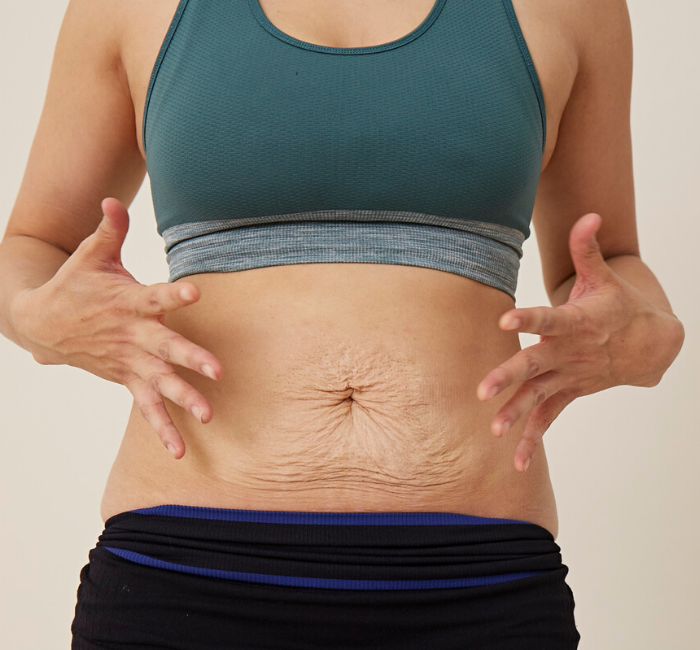What is Postpartum Diastasis Recti?

There are all sorts of ways in which pregnancy and birth can affect your body which no one tells you about and diastasis recti is one of them.
Also known as stomach muscle separation, this is a normal occurrence that happens to every woman who goes through pregnancy.
What Is Diastasis Recti?
Postpartum Diastasis Recti is a deep and wide abdominal gap between the rectus abdominis or six-pack muscles. These are the most superficial layer of abdominal muscles that run from our ribs to our pelvis. It’s normal to have a gap in the middle between these muscles. The size of the gap usually varies between 0-3cm for most men and women. This isn’t considered a diastasis.
A gap in the middle of the rectus abdominis is normal and useful for the abdominal wall to move and glide with movement and raised intra-abdominal pressure (IAP). It is also normal for pregnancy to further widen the gap in 100% of women, to allow the bump to grow outwards. After pregnancy, the gap should return, more or less to where it was before (between that normal range of 0-3cm).
There is a layer of connective tissue that runs between the sides of the rectus abdominis called the linea alba. It acts as a bridge and allows the two sides of the muscle to communicate with each other. In some pregnant women, the linea alba will become quite stretched out and lose some of its usual tension and integrity. This is known as diastasis recti.
How to Check the Gap
Lie on the floor with your knees bent and a pillow behind your head. Place your fingers gently resting just above your belly button. Raise your upper body slightly to increase the tension on your abdominal muscles, then sink your fingers down and side to side until you find the borders of the rectus abdominis. Check how deep your fingers can sink into the gap, this will give you an idea of what the integrity of your linea alba bridge is like. Keeping a note of these measurements will help you see improvement in the future. Let’s look at how to care for your abdominal gap.
Stand Straight
Pregnancy and giving birth will change the way you stand. Watch out for your hips drifting in front of you and your ribs flaring out and up in front of you. This kind of alignment may pull on the connective tissue that spans your gap, preventing recovery over time. Try to stack yourself up with your pelvis under your ribcage. If you look sideways in the mirror, your hips should be over your heels and your shoulders should be over your hips. Check your lower ribs with your hands. They should feel like they are cylindrical over your pelvis.
Avoid Doming
Holding your breath through a physical demand, such as lifting your child, getting out of bed or doing specific exercises can raise your intra-abdominal pressure (IAP). This looks like your abdominal muscles are doming or pushing outwards and place a strain on your gap. However, that’s nothing to worry about if it happens every now and again. Just make sure you get in the habit of exhaling just before doing anything physically demanding to help reduce your IAP. This technique may be more beneficial for your gap over time. Sometimes, engaging your pelvic floor gently along with your exhalation during a demanding task will also help you to connect to your deep core muscles and avoid doming.
Create Tension on Your Gap
Any movement or exercise that helps to provide tension to the gap slightly without doming will improve your abdominal wall over time. You can check for this with your fingers. Remember to exhale and connect to your pelvic floor on the effort. If you struggle to know if you are connecting properly with your pelvic floor, then an assessment with a women’s health physiotherapist can really help give you some feedback.
Release and Relax
Sometimes excess tension in the other abdominal muscles maybe adding a strain on the gap. Massaging your abdominals (especially the upper abdominals under your ribs) with some oil is a good way to feel for any tension which may benefit from release.
Not Gripping Your Abdominal Muscles
Watch out for tummy gripping. In other words, it may feel like a good thing to pull your tummy muscles in during the day but it may be creating the wrong sort of tension and actually preventing you from connecting to the pelvic floor and deep abdominals properly. So try to keep your tummy muscles relaxed in general.
A Final Note On Diastasis Recti
Lastly, movement is medicine. If you think you have diastasis don’t be afraid to be active as that’s important for your overall health. Move and stretch, just let abdominal doming or ridging be your guide as to whether that activity or exercise is effective for you and your abdominal gap. Mix movements up and try something different. If you see or feel with your hand that your abdomen is doming or pressing outward, then that exercise or movement is not effective for your gap and you will need to modify it or try a different type of movement.
Further help can be found from a women’s health physiotherapist or a fitness professional who has a special interest and experience working with this condition.

